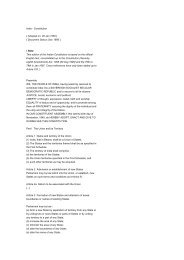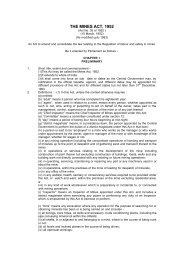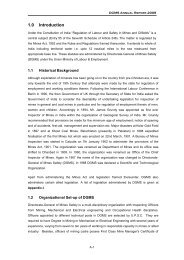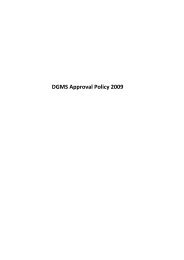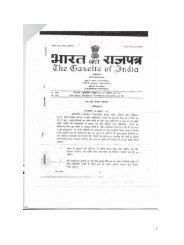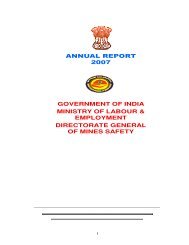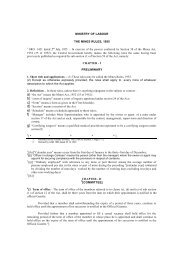Metalliferous Mines Regulations, 1961 - Directorate General of ...
Metalliferous Mines Regulations, 1961 - Directorate General of ...
Metalliferous Mines Regulations, 1961 - Directorate General of ...
Create successful ePaper yourself
Turn your PDF publications into a flip-book with our unique Google optimized e-Paper software.
(2) Where the inclination <strong>of</strong> the conveyor is such as to give rise to danger from sliding objects or material<br />
suitable devices shall be used to provide adequate protection against such danger.<br />
(3) On every length <strong>of</strong> roadway in which a conveyor is installed for transporting loads over a distance<br />
exceeding 30 metres, there shall be provided and maintained effective means <strong>of</strong> transmitting signals from<br />
every point on the length <strong>of</strong> the road to the place at which the machinery working the conveyor is operated:<br />
Provided that the Regional Inspector may, by an order in writing, require means <strong>of</strong> transmitting signals in<br />
the reserve direction also.<br />
(4) No belt conveyor shall be used in a mine belowground without the permission in writing <strong>of</strong> the Chief<br />
Inspector and subject to such conditions as he may specify therein.<br />
101. Examination <strong>of</strong> haulage engines and track etc. – (1) It shall be the duty <strong>of</strong> a competent person to<br />
examine carefully -<br />
(a) once at least in every 24 hours, every haulage engine, brake-wheel, rope and other appliance in use;<br />
and<br />
(b) once at least in every seven days, every track where the haulage is effected by means <strong>of</strong> mechanical<br />
power <strong>of</strong> gravity, and every safety contrivance fitted thereon.<br />
(2) A report <strong>of</strong> every such examination shall be recorded in a bound paged book kept for the purpose, and<br />
shall be signed and dated by the person who made the examination.<br />
102. Examination <strong>of</strong> haulage and travelling roadways – It shall be the duty <strong>of</strong> the forman or other<br />
competent person to examine carefully, once at least in every seven days, the state <strong>of</strong> all haulage and<br />
travelling roads and roadways, including roadways leading to all the outlets <strong>of</strong> the mine which are in use. A<br />
report <strong>of</strong> every such examination shall be recorded in a bound paged book kept for the purpose, and shall<br />
be signed and dated by the person who made the examination.<br />
103. Locomotives – (1) No locomotive shall be used belowground otherwise than in accordance with the<br />
permission in writing <strong>of</strong> the Chief Inspector and subject to such conditions as he may specify therein.<br />
(2) No locomotive shall be used where the gradient <strong>of</strong> the track exceeds 1 in 15.<br />
(3) No person other than the driver shall ride on any locomotive unless authorised in writing to do so by the<br />
manager.<br />
(4) Except during shunting operations, the locomotive shall lead the tubs or set or train <strong>of</strong> tubs.<br />
104. Movement <strong>of</strong> railway wagons – (1) No adolescent shall be employed in moving railway wagons.<br />
(2) The movement <strong>of</strong> railway wagons shall be carried on under the supervision <strong>of</strong> a competent male person<br />
who shall himself control the brake.<br />
(3) Before wagons are moved, persons likely to be endangered shall be warned by the competent persons<br />
appointed under sub-regulation (2).<br />
(4) No person shall move or attempt to move a wagon by pushing at the buffer, or by pulling from in front.<br />
(5) Where two or more wagons are moved simultaneously, the wagons shall be coupled together, and the<br />
number shall not exceed the number which can be effectively controlled; they shall be moved only by<br />
pushing from the sides or from behind the last wagon.





